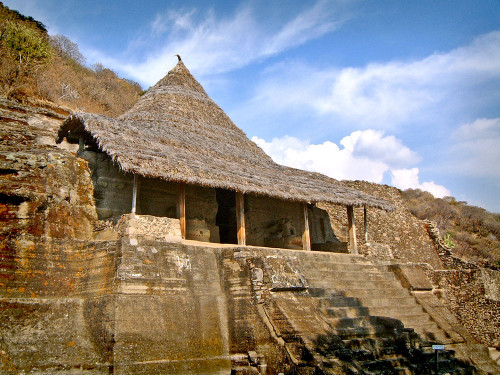
W0130: The CuauhcalliAt the heart of the Cuauhtinchan complex at Malinalco is Structure I. Known more familiarly as the Cuauhcalli, or House of the Eagles, Structure 1 is carved directly into the hillside and is the only known example of a monolithic edifice to be built by the Aztec. It is hard to imagine the effort and complexity that the builders faced, with only simple tools at their disposal and the pressure of knowing that a single mistake could have mean construction would have to be abandoned. The concept is simple – carve away at the bedrock to create a hollow cave-like temple. However, the designers chose to carve the stairs, the statues either side of the stairs, more statues either side of the entrance, a bench around the interior of the temple, ornamental animal pelts on top of the bench and an eagle into the temple floor. All of this was to be achieved in a single carving and had to be planned and accounted for before the first chisel hit the rock-face.
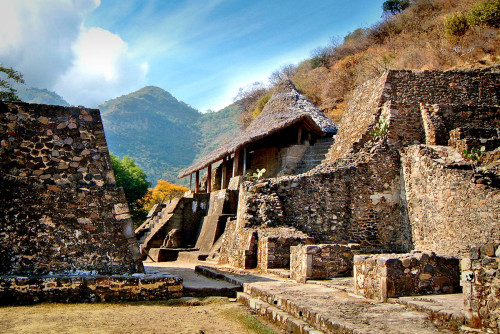
W0135: Cauachalli TempleWorking from the outside in, as the carvers would have had to work, the first feature of this complicated monolithic building would have been the foot of the stairs. Either side of the stairway sit the remains of two sentinel jaguars can still be found. The jaguars were painted yellow with black spots, but almost all of this painted finish was washed away during the five centuries that they sat here alone and unknown. Time also removed their heads, but their distinctive bodies, curling tails and large claws leave little doubt they were once jaguars or ocelots. These defining features also demonstrate the care and attention that was paid to the minutia of the feline form, in particular around the claws, which despite the state of disrepair can still be witnessed on the eastern jaguar (which is just about visible in fig. W0135, where you can see a figurine in front of the side wall of the stairs to the Cuauhcalli in the distance – click to enlarge).
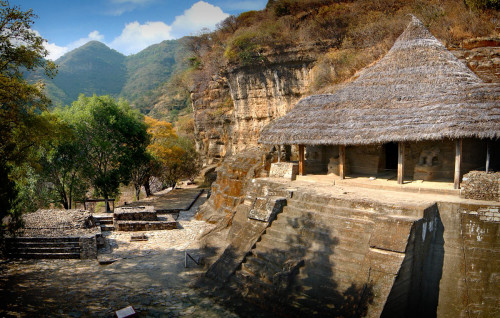
W0141: Structure I, VI, VII & VIIINext on the builders itinerary would have been the warrior statue that is sat on the narrow steps that rise steeply to the Cuauhcalli. Only the torso and legs remain (which are just about visible amongst the shadows in fig. W0141) of a warrior who is sat in the middle of the fifth step with his feet resting on the third step from bottom (click to enlarge). The upper half of the figure, like all of the statues surrounding the Cuauhcalli, has long since vanished and was probably sent tumbling down the hill either deliberately by the people of Malinalco after they were defeated by the Spanish, or by rock falls and mud slides – which also cleared away parts of Structure II and IV (which have subsequently been reconstructed). The figure would most likely have been a wise and powerful looking Eagle Warrior who would have evoked pride and passion in the warriors who made it to this special sanctuary to receive their initiation into the elite warrior clans of the Eagle or the Jaguar. Alternatively, it may have been an image of Huitzilopochtli, the warrior God who led the Aztec to greatness and from whom the Mexica peoples believed they were descended.
One element the builders did not have to carve is the an altar, or sacrificial stone. Instead, they carved s a small rectangular hole at the top of the stairs into which an temporary sacrificial stone could be inserted (the hole is just about visible in above the top step fig. W0141). One such stone has been discovered and features a turkey, which is thought to be an emblem of Calixtlahuaca. This could support the theory that the Hill of Idols was a camp for elite warriors who would come here to be awarded the title of Eagle or Jaguar Warrior for their bravery and ability on the battlefield. Each sect could then bring their own sacrificial stone to use for the initiation rites of their warriors.
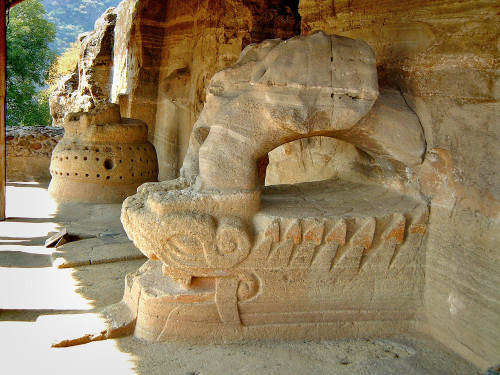
W0134: Cuauhcalli Patio CarvingsNext on the builders list of things to carve would have been the patio and its carved monuments. To the east of the doorway is a carved serpent with the remains of a warrior sat on top, and to the west of the door is a carved drum (see fig. W0134). Both of these were carved out of the rock-face as they hacked back into the hill to create the temple. The serpent clearly has arrow-like tips running along its back instead of scales, which could simply be emblematic of the warrior, although they also look like mushrooms, which could allude to the use of hallucinogens during initiation rites undertaken within the temple. A bifurcated tongue flops from the serpent’s mouth, leaving no doubt that the creature is serpentine. The remains of the human figure above has bent legs to suggest he is in a seated position – but this makes the missing upper-half a complete mystery. The sculptors could have quite easily chosen to leave the man’s back resting against the wall in high relief (which would still be attached to the wall to this day), but instead it looks as though they chose to carve him out in the full (which subsequently allowed him to breakaway). There are also the remnants of feet on top of the drum on the other side of the doorway, and from the mark on the wall behind, it seems clear that another man sat on top of the drum in the same way the man sits upon the snake. Although it is called a drum, there is little to evidence to support this theory – it looks more like a hive or nest. The serpent theme is continued around the doorway into the temple, where the entrance has been carved to look like a gaping serpents mouth, complete with forked tongue flopped out to form the step into the temple (this is just about visible midway between the serpent and the drum in fig. W0134).
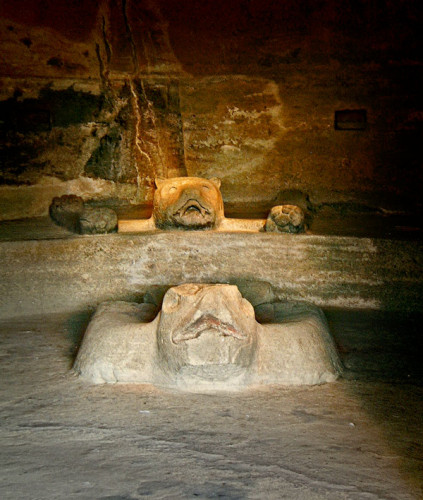
W0132: Cuauhcalli InteriorThe primary objective, to hollow out the rock-face to create a grand temple, would have been the last task undertaken. True to form, the designers did not take the easy option within the temple either, which was carved into a large conical space. A bench runs around the perimeter, which would have been simple enough to leave as the rock was hewn away. However, directly at the rear from the entrance, an ornamental jaguar skin was carved upon the bench and on either side of the temple eagles were also carved upon the bench, with a third eagle carved upon the floor at the centre of the temple (see fig. W0132). As with the carvings outside, the detail with which these effigies were engraved is astounding. That they were carved as the temple was hollowed out of the cliff face makes their perfection all the more remarkable. Behind the central eagle carved into the floor is a small circular hole into which blood offerings could be poured. As for the purpose of the eagles, the common belief is that they are ornamental pelts that were designed to be sat in. Though this make sense, as that is what animal pets were used for, there is no doubt they look like monumental dishes in which offerings could be placed or incense could be burned during the rituals that took place.
Whilst the general consensus is that Structure I was a temple for the Eagle and Jaguar Warriors, there is a growing belief that the temple may have been a solar clock, and in fact some of the other buildings (in particular Structure IV) suggest that the Cuauhtinchan complex may have been an observatory. The placement of the eagles within Structure 1 are the basis for these arguments, as the southern facing doorway could have restricted light from entering the temple and illuminating the central eagle on all but one special day, the winter solstice, when the sun us at its lowest in the sky and can therefore arc beneath the doorway and just about reach the eagle. The three aligned eagles could also have been used by creating tubes in the roof of the temple (the current roof is a faithful reproduction based on pictures of Aztec temples drawn within contemporary codices). The most obvious would have been to create a “zenith tube”, which was a popular Mesoamerican device that only allowed the sun to shine directly through it on certain days – this was normally when the sun passed directly overhead, hence the name “zenith-tube”, but it could equally be manufactured to only work on the equinoxes. Similar tubes or openings could have been manufactured to illuminate the other eagles that are located on the east and western sides of the temple’s interior – the priestly observer would sit upon the symbolic jaguar pelt. It is also possible that the eagles were made for sitting on to observe the night sky through star holes made in the roof.

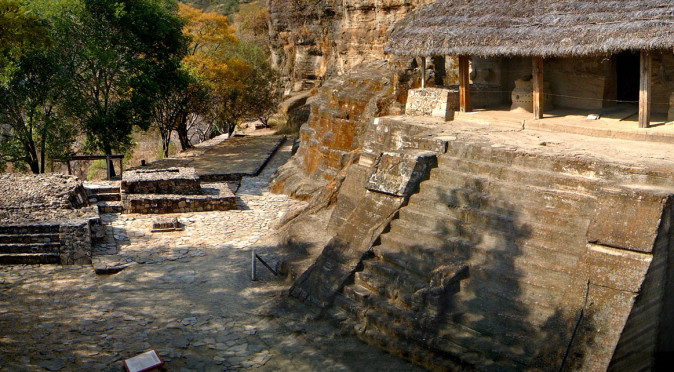
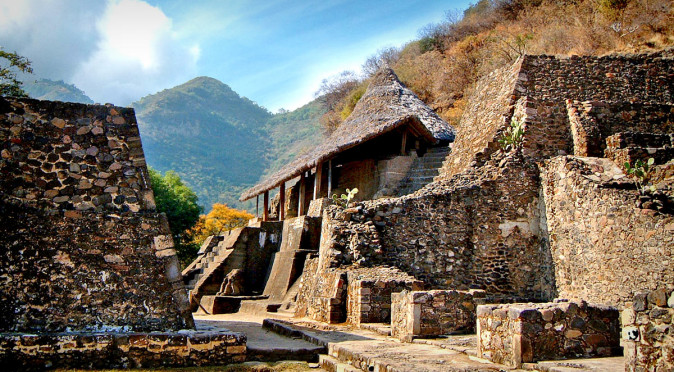
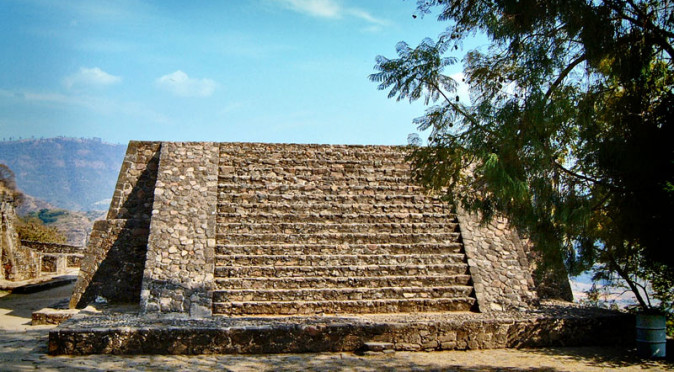
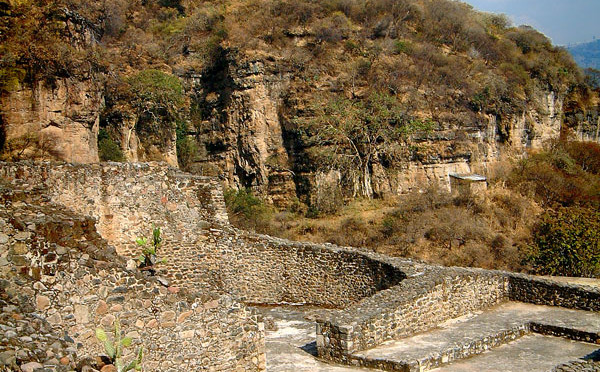
Dear sir , I would like to have permission to use a few pictures about 3 from this site in my book I am writing. I will give credit to this site . Tom
Hi Tom,
Thank-you for your interest and for asking permission first. All I usually ask for is photo credit and a copy of the publication. So if you are happy with that, then just let me know the image references (e.g. W0130, etc) and I’ll send through the original copies.
Out of interest, what is the book about?
Many Thanks,
Robin Heyworth